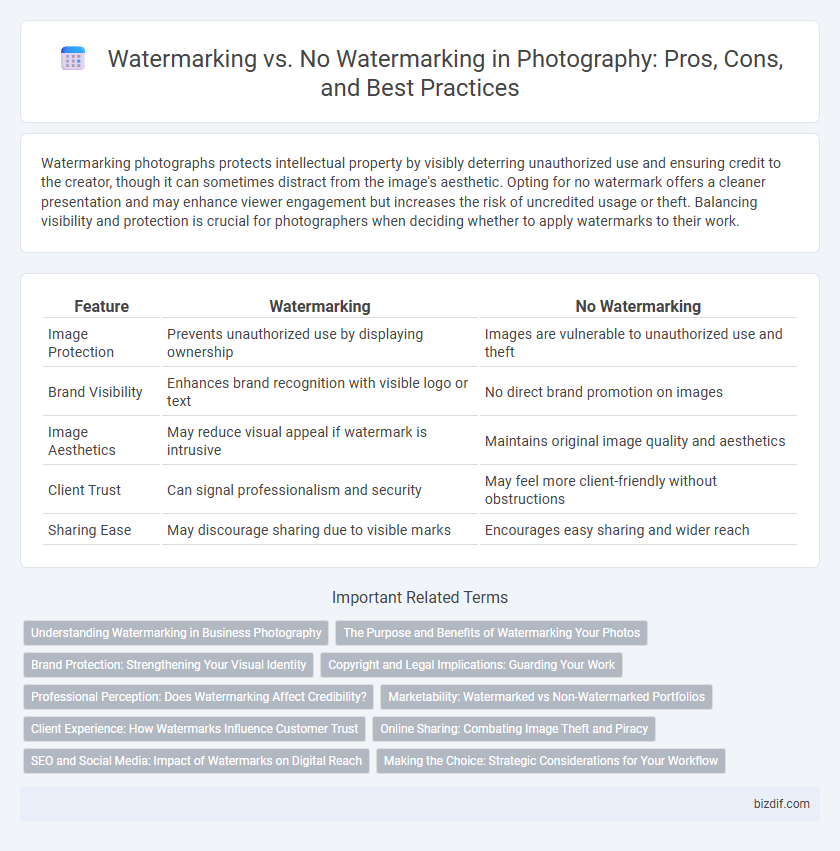Watermarking photographs protects intellectual property by visibly deterring unauthorized use and ensuring credit to the creator, though it can sometimes distract from the image's aesthetic. Opting for no watermark offers a cleaner presentation and may enhance viewer engagement but increases the risk of uncredited usage or theft. Balancing visibility and protection is crucial for photographers when deciding whether to apply watermarks to their work.
Table of Comparison
| Feature | Watermarking | No Watermarking |
|---|---|---|
| Image Protection | Prevents unauthorized use by displaying ownership | Images are vulnerable to unauthorized use and theft |
| Brand Visibility | Enhances brand recognition with visible logo or text | No direct brand promotion on images |
| Image Aesthetics | May reduce visual appeal if watermark is intrusive | Maintains original image quality and aesthetics |
| Client Trust | Can signal professionalism and security | May feel more client-friendly without obstructions |
| Sharing Ease | May discourage sharing due to visible marks | Encourages easy sharing and wider reach |
Understanding Watermarking in Business Photography
Watermarking in business photography serves as a crucial tool for protecting intellectual property and promoting brand identity by embedding logos or text on images. Using watermarks helps deter unauthorized use and ensures that the photographer or company receives proper credit, which can enhance marketing efforts and client trust. However, balancing visibility and subtlety in watermark placement is essential to maintain image aesthetics while safeguarding the creative work.
The Purpose and Benefits of Watermarking Your Photos
Watermarking your photos protects intellectual property by visually associating your work with your brand, deterring unauthorized use and ensuring credit. It enhances brand recognition when images are shared across social media platforms, driving traffic back to your portfolio or website. Photographers secure both legal and marketing advantages through clear identification, which is especially crucial in the digital age where image theft is prevalent.
Brand Protection: Strengthening Your Visual Identity
Watermarking your photographs significantly enhances brand protection by visibly embedding your logo or signature, discouraging unauthorized use and reinforcing your visual identity across digital platforms. Without watermarking, images are more vulnerable to theft or misuse, weakening brand recognition and control over your creative content. Consistent use of watermarking across your portfolio helps establish a professional and recognizable brand presence in the competitive photography market.
Copyright and Legal Implications: Guarding Your Work
Applying watermarks on photographs serves as a visible deterrent against unauthorized use by clearly indicating ownership and copyright protection, helping photographers legally assert their rights. Without watermarks, images are more vulnerable to theft and misuse, making it harder to prove originality and infringement in legal disputes. Copyright registration combined with watermarks significantly strengthens a photographer's ability to safeguard their work and seek legal remedies against infringement.
Professional Perception: Does Watermarking Affect Credibility?
Watermarking in photography can enhance professional perception by signaling ownership and deterring unauthorized use, which bolsters a photographer's credibility. However, excessive or obtrusive watermarks risk distracting viewers and may undermine the perceived quality of the image. Balancing subtle watermark placement helps maintain artistic integrity while protecting intellectual property, sustaining positive professional recognition.
Marketability: Watermarked vs Non-Watermarked Portfolios
Watermarked portfolios often protect photographers' intellectual property and can deter unauthorized use, but may distract potential clients and reduce visual appeal. Non-watermarked portfolios showcase images in their purest form, enhancing aesthetic impact and increasing marketability among buyers who prefer unobstructed visuals. Balancing protection and presentation is crucial, as client preferences vary based on market segment and usage intent.
Client Experience: How Watermarks Influence Customer Trust
Watermarks on photographs can enhance client trust by clearly indicating authenticity and protecting the photographer's intellectual property, fostering confidence in professional quality. Conversely, images without watermarks offer a cleaner viewing experience that prioritizes visual appeal, potentially improving emotional engagement but risking unauthorized use. Striking a balance between protecting work and maintaining aesthetic appeal is crucial for optimizing client experience and trust in photography services.
Online Sharing: Combating Image Theft and Piracy
Watermarking images acts as a visible deterrent against unauthorized use by embedding identifiable text or logos, making it easier to claim ownership and reducing the risk of image theft during online sharing. Photographers without watermarks rely on metadata or legal enforcement, but these methods are less effective in preventing piracy or quick redistribution on social media platforms. Balancing visibility with aesthetics, watermarking remains a crucial strategy for protecting digital photography assets against widespread online infringement.
SEO and Social Media: Impact of Watermarks on Digital Reach
Watermarking images can protect photographers' intellectual property and enhance brand recognition on social media platforms, improving SEO by associating content directly with the creator's portfolio. However, excessive or intrusive watermarks may reduce user engagement and sharing, limiting the potential organic reach and backlinks that boost search engine rankings. Balancing subtle watermark placement helps maintain visual appeal while safeguarding copyright and promoting digital visibility.
Making the Choice: Strategic Considerations for Your Workflow
Choosing between watermarking and no watermarking in photography depends on balancing image protection with visual appeal; watermarks deter unauthorized use but can distract from the composition. Evaluating your target audience, distribution channels, and branding goals helps determine the effectiveness of watermark application within your workflow. Incorporating non-intrusive, strategically placed watermarks can safeguard intellectual property while maintaining image integrity and viewer engagement.
Watermarking vs No Watermarking Infographic

 bizdif.com
bizdif.com